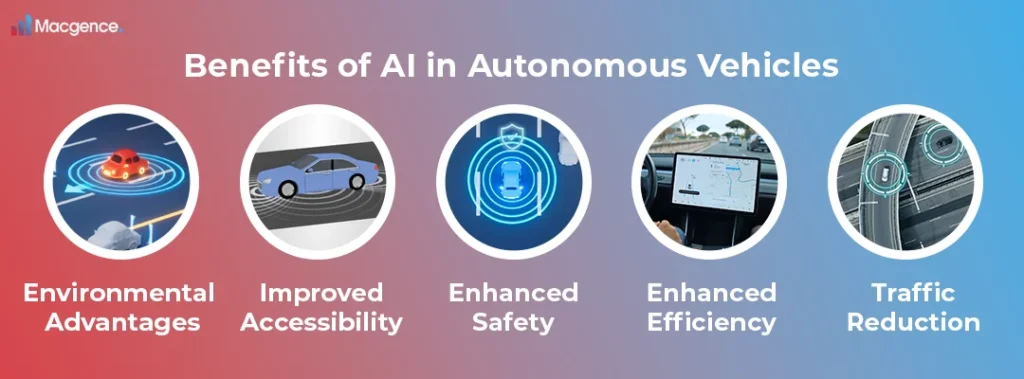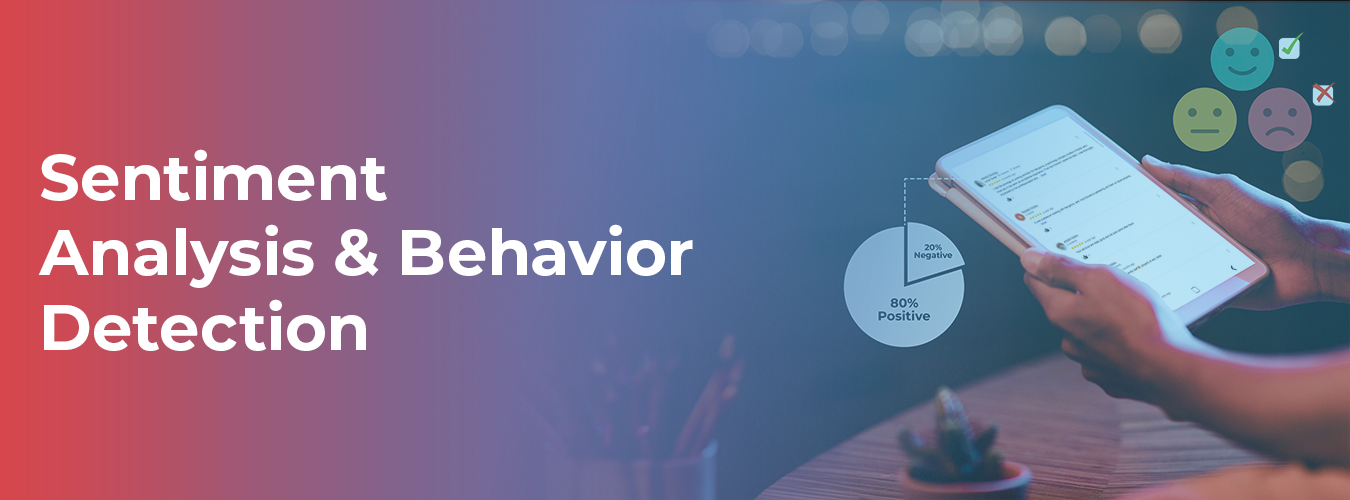In recent years, artificial intelligence (AI) advancements have paved the way for revolutionary changes in numerous industries. One region that has witnessed significant transformation is transportation. The emergence of automobiles and Advanced Driver Assistance Systems (ADAS) has reshaped our views on commuting, promising more desirable safety, efficiency, and comfort. At the heart of this transformation lies the combination of AI in autonomous vehicles, enabling them to perceive, reason, and make knowledgeable selections, just like human drivers. By combining sensors, cameras, and robust computing structures, AI algorithms can process vast records in real-time, allowing autonomous vehicles to navigate roads, avoid obstacles, and react to dynamic traffic situations. This blog will dig deeper into the multifaceted function of AI in automobiles, exploring the role of AI, its use cases in the automobile industry, its benefits, and much more.
Role of AI in Autonomous Vehicles

Adopting AI in autonomous vehicles and traffic systems has converted the automotive industry beyond belief. Using ML algorithms, vehicles can adapt to changing street conditions and evolving traffic eventualities, making driving more steady, convenient, and efficient. AI has also played a crucial role in advancing electric and hybrid cars, enabling manufacturers to maximize designs for the most efficient operation and minimal energy consumption. Leveraging AI technology for self-driving vehicles is instrumental in various crucial functions, including
Predictive Modeling
AI in autonomous vehicles can predict the conduct of pedestrians and different vehicles via AI. The car is prepared with predictive modeling and analytics capability to anticipate such troubles and prevent them from taking place.
Sensing and Perception
Self-driving motors depend on various sensors, such as lidar, cameras, ultrasonic sensors, and radar, to acquire specified data regarding their environment. AI in autonomous vehicles analyzes this data to generate detailed environmental maps and help make informed decisions. ·
Natural Language Processing
Some self-driving automobiles use voice recognition to engage with passengers using Natural language processing (NLP). This relies on AI expertise, answering spoken commands in maps and detecting relevant objects such as pedestrians, different vehicles, traffic lights, and road signs.
Decision Making
AI in autonomous vehicles enables on-spot decisions primarily based on real-time sensor data. For instance, while a self-driving car senses a pedestrian crossing the road, AI helps determine the high-quality reaction, like slowing or stopping.
AI in Self-Driving Automobile Use Cases
The myriad use cases of AI in autonomous vehicles vividly explain the transformative power of AI in revolutionizing the automotive sector and elevating safety and operational efficiency. These pioneering applications of AI within self-driving cars include
Processing Sensor Data
The central vehicle computer collects data in real-time from sensors that inform the vehicle about the traffic, the road, and any possible hindrances. Intelligent algorithms like artificial neural networks (ANN) to detect and identify objects ahead and around the vehicle smartly interpret these data streams. It has dedicated hardware and software modules for sensors and is capable of parallel processing, which supports efficient decisions.
Trajectory Optimization
Path planning is essential for maximizing the vehicle’s trajectory and traffic control. This dynamic task involves several components which are amenable to intelligent artificial algorithms. AI in autonomous vehicles uses prior driving experiences to pick the safest, most convenient, and most economical ways from point A to point B.
Navigating Road Conditions
The vehicle plans the path and uses AI-based algorithms to manage different road conditions, including objects, pedestrians, bicycles, and traffic lights. Object detection algorithms make Human-like behavior possible, but they face challenges when dealing with differing road and weather conditions.
Predictive Maintenance
One promising approach is predictive maintenance, which uses machine monitoring and predictive modeling to predict such failure. Using both supervised and unsupervised learning techniques, AI in autonomous vehicles can mine the onboard and offboard data to predict and avoid future problems, translating to immense savings in time and money.
Insurance Data Analysis
Vehicle data logs offer critical driver behavior information that might be beneficial in traffic accident investigations and insurance claims. As the focus moves towards automated vehicles, liability becomes a central issue, with manufacturers taking up more responsibility. Like black box data in aviation, storing relevant snapshots of sensor data after an incident for post-event analysis will be essential, providing critical evidence for accident investigations and insurance claims.
Benefits of AI in Autonomous Vehicles

The use of AI in autonomous vehicles has brought a new era of increased safety, improved operations, and many more perks. Some of the top benefits of AI in self-driving cars include:
Environmental Advantages
With electric or hybrid engines in self-driving cars, the emissions of greenhouse gases are reduced, which is a massive step in keeping the environment safe. Moreover, AI in autonomous vehicles contributes to eco-friendliness via optimal driving behaviors, energy-saving acceleration, and fuel-saving, decreasing automobiles’ environmental effects.
Improved Accessibility
Cars with built-in AI cater to people who are disabled or have mobility problems by providing auto-parking, wheelchairs, and voice commands. This accessibility is exemplified in Tesla’s “summon” feature, where the car can navigate tight spaces and come to the passenger when called. This promotes autonomy and convenience for individuals who cannot drive independently.
Enhanced Safety
Features such as adaptive cruise control, ACC, lane departure warning LDW, and automatic emergency braking AEB with AI-integrated have greatly enhanced the safety of passengers. This kind of safety feature is one of the prime benefits of AI in autonomous vehicles, as it can detect obstacles and hazards using its sensors and cameras and thereby take necessary precautions, ensuring aversion of accidents.
Enhanced Efficiency
In designing self-driving cars, AI develops more economical routes and lowers energy usage and travel time. AI uses real-time traffic data monitoring and road conditions to guide vehicles effectively. It also regulates acceleration and braking patterns to minimize energy consumption and prolong the vehicle’s life.
Traffic Reduction
Self-riding vehicles also have AI, which allows them to communicate with each other and share real-time site visitor information, thereby allowing them to pick non-congested routes. This ability minimizes traffic jams and ensures that traffic is evenly allotted on unique roads, making our streets more secure and effective.
Make Your Mark in the Automotive Industry with Macgence as Your Partner
AI in autonomous vehicles has redefined the automotive industry and paved the way for a transformative future of transportation. Advancements in riding technology and AI algorithms convey an essential shift in vehicle protection, efficiency, and user experience. The potential for AI in self-driving automobiles is infinite, promising continuous improvements and groundbreaking innovations. Suppose you want to experience the revolutionary power of AI in your business and partner with Macgence. Our cutting-edge AI development services drive technological excellence and innovation. Connect with our experts today to explore our AI solutions and services.
FAQs
Ans: – Real-time data from cameras, lidar, and radar helps the AI in self-driving cars interpret the environment. Algorithms analyze this data to navigate, avoid obstacles, and follow traffic rules.
Ans: – AI in self-driving cars is used for sensing, decision-making, predictive modeling, and natural language processing. This enables them to detect objects, predict behavior, plan routes, and communicate with passengers, ensuring a safe driving experience.
Ans: – The advancements in AI capabilities will bring a host of autonomous features that will bring efficiency, safety, and dependability to self-driving cars. These advancements promise to unlock the newest innovation, making autonomous driving the future of mobility solutions.




